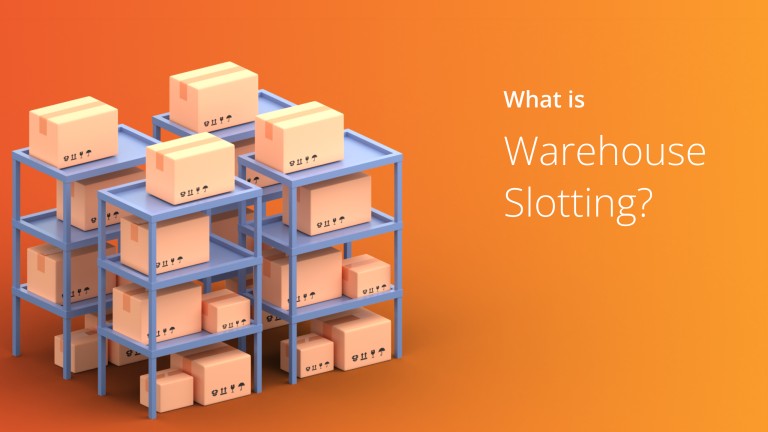Warehouse slotting is something that many eCommerce and delivery company owners or warehouse managers know of but don’t quite understand.
It’s an essential part of your inventory management and optimization, directly affecting storage costs and the speed at which orders are processed. This blog post introduces a comprehensive guide to slotting strategy to ensure you can maximize your warehouse operations.
You’ll learn about warehouse slotting strategy, its benefits, the differences between macro and micro warehouse slotting strategies, and the differences between the random and fixed slotting process.
Moreover, you’ll find helpful insights into slotting your inventory and best practices for doing so efficiently.
Keep reading if you want to grasp everything there is to know regarding managing your stock better strategically.
Table of Contents
What is Warehouse Slotting?
Warehouse slotting is strategically organizing products within a warehouse based on their demand, size, weight, and other factors to optimize efficiency and reduce lead times.
By analyzing order history and product specifications, warehouse and distribution center managers can determine the ideal storage location for each item.
For example, high-demand items are typically placed near the front of the warehouse, while low-demand items are placed in the back. This way, workers can easily find the necessary items without wasting time searching the entire warehouse. This saves time and reduces the risk of errors and damages during the picking process.
Want To See For Yourself How Route4Me Can Optimize Pick-and-Pack routes efficiently ?

Benefits of Warehouse Slotting
Warehouse slotting offers several distinct benefits which can improve the efficacy of a warehouse’s operations.
Improves Productivity
Slotting is the careful and strategic placement of inventory within a warehouse or distribution center. This allows for improved efficiency in picking, packing, shipping, and other such processes by enabling employees to identify the items they seek more quickly and accurately.
By properly slotting a warehouse inventory, employees will spend less time searching for the correct item and more time processing it. This boosts productivity in getting orders out faster and improves accuracy due to fewer errors when locating items.
Increases Safety
Another clear benefit of properly placed goods is increased safety in the warehouse. Optimized slotting makes employees less likely to experience hazardous conditions with spills or falling objects due to misplaced stock.
Additionally, slotted shelves can provide additional support for products that may require them due to weight or delicate goods. Otherwise, such items can get damaged when in contact with rough surfaces or materials that are inappropriate for storage.
Reduces Costs
Effective warehouse slotting ensures that inventory takes up less physical space. This reduces warehousing costs as businesses don’t need to lease larger premises or incur lengthy reorganization expenses.
Plus, it reduces overall labor costs as pickers and packers save time while performing tasks.
Improves Customer Satisfaction
Slotting a warehouse correctly ensures all necessary items are accessible quickly and efficiently from one location within a warehouse (rather than having multiple locations requiring cross-referencing).
This helps rapidly fulfill and ship customer orders with minimal interruption, delay, or shipping errors. Ultimately, it boosts consumer trust in an organization’s services and its reputation for reliability and dependability.
Provides Better Visibility Over Inventory Levels
Warehouse slotting provides real-time insights into what parts are available at any given time. This helps retailers avoid common issues such as running out of stock unexpectedly or incorrectly forecasting demand levels resulting in overstocking unsellable items.
This enables businesses to make better decisions about purchasing additional stock based on actual data rather than relying purely on intuition or guesswork. It ultimately saves them money by only buying what they need.
Reduces Carbon Footprint
Proper slotting contributes towards environmental sustainability since it minimizes travel distances within a warehouse. This means less fuel consumption by forklifts resulting in fewer emissions such as carbon dioxide, carbon monoxide, etc. It reduces the damage such pollutants cause around us over a long period.
Macro Slotting vs. Micro Slotting
Macro slotting strategy involves considering the big picture of warehouse layout and storage, such as where to place different types of products based on their storage requirements.
On the other hand, micro-slotting focuses on the details of each product and determines the best storage location based on its specific dimensions, weight, and ease of accessibility.
Macro slotting is like sorting your closet by shirts, pants, and jackets, while micro slotting is like organizing your shirts by color, sleeve length, and material.
Ultimately, the main difference between the two is the level of granularity they use to organize products.
While both approaches are essential for optimizing warehouse operations, finding the right balance between them can lead to a well-organized and smoothly functioning warehouse.
Random Slotting vs. Fixed Slotting
Regarding slotting items in a warehouse, there are two main approaches: random slotting and fixed slotting.
Random slotting means randomly assigning items to available locations, while fixed slotting involves assigning each item to a predetermined spot.
While each approach has pros and cons, the decision ultimately depends on your unique business needs. Random slotting can be more flexible and save time in the short term. But fixed slotting provides consistency and can optimize space over the long term.
Whether you choose random or fixed slotting, it’s essential to take the time to evaluate your inventory and find the best system for your specific operation.
Multi-Stop Route Planner App

How to Perform Warehouse Slotting
Here is a step-by-step process for warehouse slotting:
Step 1: Determine the Warehouse Layout
The first step in the warehouse slotting process is determining the warehouse layout, including which shelves or locations should be used for which items.
This will help ensure your staff can pick up orders quickly and accurately since items will already be close together.
Step 2: Analyze Items
Analyzing each item within the warehouse helps identify characteristics such as size, shape, weight, fragility, and any special considerations like expiration dates or environmental conditions needed for storage.
Step 3: Slot Items into Locations
After analyzing each item and determining where it should go within the warehouse, it’s time to start organizing inventory and slotting them into their respective locations.
The allocations should typically be based on frequency requirements, seasonality trends, and order profiles analyzed from existing customer purchase history or shipping records.
Step 4: Document Procedures
Last but not least, document complete procedures established through slotting processes. This makes sure employees adapt them swiftly while fulfilling orders daily.
It helps keep delivery systems efficient and free from bottlenecks by ensuring knowledge transfer between predecessors and successors, even during vacations or quick staff turnover.
Best Practices for Warehouse Slotting
Below are some best practices you should consider to make your slotting process efficient.
Ask for Feedback from Pickers
Gathering feedback from pickers is a great way to improve warehouse slotting efficiency. This allows you to identify areas where the process can be improved or streamlined, such as picker wait times, inability to find items quickly and easily, or other issues that may arise.
Through regular feedback from pickers, you can adjust slotting models and allocations to help optimize their workflow and increase overall productivity and efficiency within the warehouse.
Audit Slot Layout
By carefully auditing and regularly analyzing the current slotting system, you can make improvements to ensure faster picking times and overall efficiency.
For example, by taking a closer look at which items are regularly picked and in what quantity, it is possible to determine whether changes need to be made.
This can include moving products around for easier access, grouping certain items, or creating dedicated spaces for frequently-used items.
Quantify Results
Measure results quantitatively and compare them with pre-slotting performance metrics. This would help you determine whether your efforts yield desired outcomes. Thus, allowing you to pinpoint necessary alterations if required in particular situations.
Use a Warehouse Management System
A warehouse management system can significantly reduce the time spent on manual tasks related to managing inventory levels and planning for demand.
This includes forecasting stock needs based on sales history and helping optimize stocking and restocking procedures.
Additionally, a WMS helps ensure that orders are fulfilled accurately and quickly, which can lead to improved customer satisfaction through faster delivery times.
Common Mistakes to Avoid When Slotting Warehouses
When it comes to warehouse slotting, the most common mistakes include the following:
Poor Planning
Not accounting for future growth can lead to inefficient slots and overcrowding. Failing to plan ahead and using too many large items in small slots can also lead to wasted space or a shortage of inventory storage space.
Neglect of Storage Area Maintenance
Inadequate maintenance leads to dust and dirt accumulation on shelves and sometimes ill-fitting items that impede efficient slotting practices. This can also cause damage to products or create safety hazards.
Not Optimizing Slot Dimensions
Without considering the size and shape of items, even the best warehouses are not optimized for maximum productivity. Unused storage space is just as expensive as inadequate storage, so find ways to fill gaps with smaller items and make the most out of your new warehouse space slots.
Lack of Automation
Manual processes are prone to errors and slow down workflows, decreasing efficiency when slotting warehouses. Consider incorporating automated processes such as barcode scanning or voice recognition. These systems increase accuracy and productivity while also lowering labor costs.
Failure To Utilize Technology
Many warehouses have yet to take full advantage of robotics or automation tools that could significantly improve slotting times and accuracy levels.
Leveraging technology can help reduce human error, rapid inventory replenishment times, improve customer service capabilities, and more accurate order picking.
Final Thoughts about Warehouse Slotting Strategy
In conclusion, warehouse slotting optimization can be intimidating at first. However, once you understand the various methods and best practices associated with it, you can reap the benefits of improved efficiency and maximum space utilization in your warehouse.
But slotting your warehouse is not the only way to save time and money. You should also leverage route optimization software to boost efficiency.
For example, Route4Me’s delivery planner simplifies and streamlines pick-and-pack routing inside warehouses and yards for robotic and human operators.
Just describe the items in each part of your warehouse or yard, and our algorithm will map the most efficient routes to help with loading or picking. It also considers weight limitations and other capacity requirements so your robots are never overloaded. Additionally, you’ll get real-time analytics regarding all the routes.
Plus, Route4Me’s route optimizer helps delivery drivers find the fastest sequence of stops by avoiding obstacles like traffic jams and construction sites.
All you need to do is add customer names and addresses to get accurate routes quickly. You can assign the optimal routes to different drivers, set delivery time windows and provide customers with updates about their deliveries – all from one place.
Try Route4Me’s Get Started and see yourself.
Want To See For Yourself How Route4Me Can Optimize Pick-and-Pack routes efficiently ?











